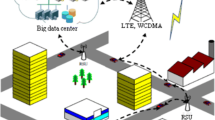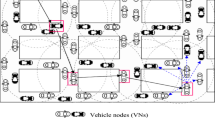Abstract
Nowadays, the routing problem has received major concern in Vehicular Ad-hoc Networks (VANETs) because of the utilization of resource-constrained devices in wireless networking environments. The traditional store-carry-forward approach produced highly reliable packet delivery performance using buses on ordinary routes. However, its performance is induced when dealing with inconsistent and dynamic routes. In addition, there is large bandwidth consumption if the forwarded packets are transmitted through improper relay nodes. Therefore, this paper proposes a novel street-centric routing algorithm with the consideration of optimal multiple routes and optimal relay node selection procedures. Initially, the street maps with ten streets and four bus routes are taken as input data. These bus trajectory data are transformed into routing graphs to determine the probability of buses moving through the streets. Subsequently, the optimal multiple shortest routes for forwarding packets to the destination are selected with the consideration of metrics such as Probability of Path Consistency (PPC) and Probability of Street Consistency (PSC). Finally, the optimal relay bus is chosen by employing the proposed Hybrid Fuzzy Niching Grey Wolf (HFNGW) algorithm. The experimental result inherits that the HFNGW algorithm achieves a greater packet delivery ratio of about 98.9% with less relay bus selection time of 32 ms than other compared methods.











Similar content being viewed by others
Availability of data and material
Data sharing is not applicable to this article as no new data were created or analyzed in this study.
Code availability
Not applicable.
References
Alaya, B., Khan, R., Moulahi, T., & Khediri, S. E. (2021). Study on QoS management for video streaming in vehicular ad hoc network (VANET). Wireless Personal Communications, 118(4), 2175–2207. https://doi.org/10.1007/s11277-021-08118-7
Luo, L., Sheng, L., Yu, H., & Sun, G. (2021). Intersection-based V2X routing via reinforcement learning in vehicular Ad Hoc networks. IEEE Transactions on Intelligent Transportation Systems. https://doi.org/10.1109/TITS.2021.3053958
Sharshembiev, K., Yoo, S. M., & Elmahdi, E. (2021). Protocol misbehavior detection framework using machine learning classification in vehicular Ad Hoc networks. Wireless Networks, 27(3), 2103–2118. https://doi.org/10.1007/s11276-021-02565-7
Hosmani, S., & Mathapati, B. (2021). R2SCDT: Robust and reliable secure clustering and data transmission in vehicular ad hoc network using weight evaluation. Journal of Ambient Intelligence and Humanized Computing, 1–18.
Ali, Z. H., Badawy, M. M., & Ali, H. A. (2020). A novel geographically distributed architecture based on fog technology for improving Vehicular Ad hoc Network (VANET) performance. Peer-to-Peer Networking and Applications, 13(5), 1539–1566. https://doi.org/10.1007/s12083-020-00910-9
Wu, J., Fang, M., Li, H., & Li, X. (2020). RSU-assisted traffic-aware routing based on reinforcement learning for urban vanets. IEEE Access, 8, 5733–5748.
Arif, M., Wang, G., Balas, V. E., Geman, O., Castiglione, A., & Chen, J. (2020). SDN based communications privacy-preserving architecture for VANETs using fog computing. Vehicular Communications, 26, 100265.
Bagga, P., Das, A. K., Wazid, M., Rodrigues, J. J., Choo, K. K. R., & Park, Y. (2021). On the design of mutual authentication and key agreement protocol in internet of vehicles-enabled intelligent transportation system. IEEE Transactions on Vehicular Technology, 70(2), 1736–1751. https://doi.org/10.1109/TVT.2021.3050614
Turcanu, I., Salvo, P., Baiocchi, A., Cuomo, F., & Engel, T. (2020). A multi-hop broadcast wave approach for floating car data collection in vehicular networks. Vehicular Communications, 24, 100232. https://doi.org/10.1016/j.vehcom.2020.100232
Ullah, N., Kong, X., Lin, L., Alrashoud, M., Tolba, A., & Xia, F. (2020). Real-time dissemination of emergency warning messages in 5G enabled selfish vehicular social networks. Computer Networks, 182, 107482.
Khan, Z., Fang, S., Koubaa, A., Fan, P., Abbas, F., & Farman, H. (2020). Street-centric routing scheme using ant colony optimization-based clustering for bus-based vehicular ad-hoc network. Computers & Electrical Engineering, 86, 106736. https://doi.org/10.1016/j.compeleceng.2020.106736
Abinaya, K., Praveen Kumar, P., Rajmohan, R., & Pavithra, M. (2022). Performance analysis of SDN-inspired swarm intelligence-based routing optimization algorithm in vehicular network. In Advances in data computing, communication and security (pp. 509–519). Springer.
Arif, M., Wang, G., Peng, T., Balas, V. E., Geman, O., & Chen, J. (2020). Optimization of communication in VANETs using fuzzy logic and artificial Bee colony. Journal of Intelligent & Fuzzy Systems, 38(5), 6145–6157. https://doi.org/10.3233/JIFS-179697
Ranjan Senapati, B., & Mohan Khilar, P. (2020). Optimization of performance parameter for vehicular ad-hoc network (VANET) using swarm intelligence. Nature inspired computing for data science (pp. 83–107). Springer.
Regin, R., & Menakadevi, T. (2021). A novel clustering technique to stop congestion occur vehicular ad-hoc networks using node density based on received signal strength. Peer-to-Peer Networking and Applications, 14(4), 2361–2371. https://doi.org/10.1007/s12083-020-00958-7
Divya, N.S., Veeramallu Bobba, D., & Vatambeti, R. (2021). A novel african buffalo based greedy routing technique for infrastructure and cluster based communication in vehicular ad-hoc network. Journal of Theoretical and Applied Information Technology, 99(5).
Mohammadnezhad, M., & Ghaffari, A. (2019). Hybrid routing scheme using imperialist competitive algorithm and RBF neural networks for VANETs. Wireless Networks, 25(5), 2831–2849. https://doi.org/10.1007/s11276-019-01997-6
Liu, J., Weng, H., Ge, Y., Li, S., & Cui, X. (2022). A self-healing routing strategy based on ant colony optimization for vehicular ad hoc networks. IEEE Internet of Things Journal.
Sun, G., Zhang, Y., Liao, D., Yu, H., Du, X., & Guizani, M. (2018). Bus-trajectory-based street-centric routing for message delivery in urban vehicular ad hoc networks. IEEE Transactions on Vehicular Technology, 67(8), 7550–7563.
Ahmed, R., Nazir, A., Mahadzir, S., Shorfuzzaman, M., & Islam, J. (2021). Niching grey wolf optimizer for multimodal optimization problems. Applied Sciences, 11(11), 4795.
Bilal, H., & Öztürk, F. (2021). Rubber bushing optimization by using a novel chaotic krill herd optimization algorithm. Soft Computing, 25(22), 14333–14355.
Song, Q., Zhao, Q., Wang, S., Liu, Q., & Chen, X. (2020). Dynamic path planning for unmanned vehicles based on fuzzy logic and improved ant colony optimization. IEEE Access, 8, 62107–62115.
Funding
Not applicable.
Author information
Authors and Affiliations
Contributions
All authors agreed on the content of the study. FSFV, SPK, JTAR and CAS collected all the data for analysis. FSFV agreed on the methodology. FSFV, SPK, JTAR and CAS completed the analysis based on agreed steps. Results and conclusions are discussed and written together. The author read and approved the final manuscript.
Corresponding author
Ethics declarations
Conflict of interest
The authors declare that they have no conflict of interest.
Ethical approval
This article does not contain any studies with human participants.
Consent to participate
Not applicable.
Consent for publication
Not applicable.
Human and animal rights
This article does not contain any studies with human or animal subjects performed by any of the authors.
Informed consent
Informed consent was obtained from all individual participants included in the study.
Additional information
Publisher's Note
Springer Nature remains neutral with regard to jurisdictional claims in published maps and institutional affiliations.
Rights and permissions
Springer Nature or its licensor (e.g. a society or other partner) holds exclusive rights to this article under a publishing agreement with the author(s) or other rightsholder(s); author self-archiving of the accepted manuscript version of this article is solely governed by the terms of such publishing agreement and applicable law.
About this article
Cite this article
Vinnarasi, F.S.F., Karuppiah, S.P., Rose, J.T.A. et al. A novel model for optimal selection of relay bus with maximum link reliability in VANET using hybrid fuzzy niching grey wolf optimization. Wireless Netw (2024). https://doi.org/10.1007/s11276-024-03752-y
Accepted:
Published:
DOI: https://doi.org/10.1007/s11276-024-03752-y




